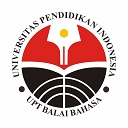Slang Abbreviation in Japanese and Indonesian Written Language: Origins, Process, Similarities, and Differences
Abstract
Keywords
Full Text:
PDFReferences
Amri, M & Karina. (2017). Abreviasi Bahasa Jepang dan Bahasa Indonesia dalam Asahi Shimbun 「朝日新聞」 dan CNN Indonesia–Kajian Kontrastif– [Japanese and Indonesian Abbreviation in Asahi Shimbun「朝日新聞」 and CNN Indonesia –Contrastive Analysis]. HIKARI, 5(3), 1-11. https://ejournal.unesa.ac.id/index.php/hikari/article/view/21402
Anita, N., Faizah, H., & Sinaga, M. (2021). Bentuk, Makna, dan Pola Slang pada Akun Media Sosial Instagram @ dagelan [Form, Mean and Pattern in Instagram Social Media Account @ dagelan]. Jurnal Tuah: Pendidikan dan Pengajaran Bahasa, 3(2), 160-170. doi: http://dx.doi.org/10.31258/jtuah.3.2.p.160-170
Ariyapitipun, S. (2007). Introduction to Linguistics Third Edition. Thailand: Polymath
Bahasa daring (2020). Bahasa Daring: Kamus Bahasa Gaul yang Ada di Sosial Media Indonesia [Internet Language: Dictionary of Slang in Indonesia Social Media]. Retrieved from https://www.bahasadaring.com/
Budiasa, I. G., Savitri, P. W., Shanti, A. S., & Dewi, S. (2021). Slang in Indonesian social media. Lingual: Journal of Language and Culture, 11(1), 30. doi: https://doi.org/10.24843/LJLC.2021.v11.i01.p06
Fang, Y. (2013). A Study of Characteristic Expressions Detectable in the Spoken Japanese of Youth. Society of Japanese Language Education Hong Kong: Nihon Gakukan, 16, 136-144. Chinese University of Hong Kong. https://japanese-edu.org.hk/jp/publish/gakkan/gakkan16.html
Haneyama, A. Kodama, E. & Wang, J. (2017). SNS-jou no hatsugen kara no kouritsutekina wakamono kotoba no chuushutsu shuhou ni kansuru kouan [An idea for an efficient method of extracting young people's words from SNS utterances]. J-STAGE: 2017 Proceedings of the Tohoku Branch Joint Conference of the Electrical Society of Japan. Iwate University. doi: https://doi.org/10.11528/tsjc.2017.0_78
Horio, K. (2015). The study on language variations and changes in Japanese new words and phrases wakamono. (Master’s Thesis). Kyushu University. doi: https://doi.org/10.15017/1500450
Iwasaki, M., Maeda, R. & Kawashima, H. (2017). Expressions of the Internet that young people pay attention to -Internet Slang and dialect-. Hachinohe Institute of Technology Repository, 36, 41-56. doi: http://id.nii.ac.jp/1078/00003611/
Kamus singkatan (2023). Singkatan, Kepanjangan dan Akronim Bahasa Indonesia [Indonesian Abbreviations, Originally and Acronyms]. Retrieved from https://www.kamussingkatan.com/
Kotoba search (2021). Kotoba no imi saachi / kotoba no imi ya tsukaikata – reibun wo wakariyasuku setsumei shimasu [Search mean of vocabulary / Explain clearly about mean of vocabulary or use and example]. Retrieved from https://kotoba-search.jp/
Kurniawati, N. (2019). Penggunaan Bahasa Gaul dalam Pembelajaran Bahasa Indonesia I SMAN 3 Ciamis [The Use of Slang in Learning Indonesian I SMAN 3 Ciamis]. DIKSATRASIA, 3(1), 1-8. doi: http://dx.doi.org/10.25157/diksatrasia.v3i1.2429
Matsumoto, K., Akita, K., Keranmu, X., Yoshida, M., & Kita, K. (2014). Extraction Japanese slang from weblog data based on script type and stroke count. Procedia Computer Science, 35, 464-473. doi: https://doi.org/10.1016/j.procs.2014.08.127
Napitu, F. E., & Suhardianto, S. (2020). An analysis of slang words abbreviation in american caption on instagram: a sociolinguistics approach. Scientia Journal: Jurnal Ilmiah Mahasiswa, 2(1). https://ejournal.upbatam.ac.id/index.php/scientia_journal/article/view/2617
Nendai ryukou (2015). Rekidai gyaru ryuukou taishou / nendai ryuukou [Successive generations gyaru buzzword awards / age trends]. Retrieved from https://nendai-ryuukou.com/article/146.html
Nikkan Sports (2021). [2021 Ryuukougo Daihyou] Nenkan daishou wa riaru nitouryuu / shootaimu / matome [2021 Buzzword Award] Annual grand prize is riaru nitouryuu / shootaimu / summarize. Retrieved from https://www.nikkansports.com/general/nikkan/news/202112010000005.html
Numan (2021). Yougoshuu / 『numan』 (nuuman) kodawari joshi no tame no ijigen kuukan magajin [Glossary / 『numan』 (nuuman) Another dimension space magazine for obsession girls]. Retrieved from https://numan.tokyo/words
Nurhasanah, N. (2014). Pengaruh Bahasa Gaul Terhadap Bahasa Indonesia [The Effect of Slang to Indonesian]. In Forum Ilmiah, 11(1) , 15-21. https://digilib.esaunggul.ac.id/pengaruh-bahasa-gaul-terhadap-bahasaindonesia-16961.html
Noviastuti, E., & Mael, M. R. (2017). Klasifikasi Bentuk Shouryakugo dalam Bahasa Jepang [The Classification of Shouryakugo in Japanese]. PARAFRASE: Jurnal Kajian Kebahasaan & Kesastraan, 17(2), 65-72. doi: https://doi.org/10.30996/parafrase.v17i2.1372
Permata, A. Z. & Mintowati. (2021). Prokem dalam Video Youtube Ngobrak Gofar Hilman [Jargon in the Youtube Video Ngobrak Gofar Hilman]. Bapala, 8(7), 38-46. https://ejournal.unesa.ac.id/index.php/bapala/article/view/43599
Putri, F. N. J. & Santoso, T. (2016). Bahasa Jepang: Ragam Bahasa Pria dan Wanita [Japanese: Variety of Men's and Women's Languages]. Yogyakarta: Morfalingua
Ragam, R. P. (2021). Pemakaian Akronim Di Lingkungan Pemerintah Kota Surabaya [The Use of Acronyms in the Surabaya City Government Environment]. Diksi, 29(2), 189-194. doi: https://doi.org/10.21831/diksi.v29i2.36533
She, Z. (2021). On the Word Formation of Loanword Abbreviations in the Modern Japanese Language. Journal of Humanities and Social Sciences, (50), 123-143. doi: http://doi.org/10.18926/61336
Simpen, I. W. (2021). Morfologi: Kajian Proses Pembentukan Kata [Morfology: Study of Word Formation Process]. Jakarta: Bumi Aksara
Tanaka, H. (1996). An invitation to sociolinguistics (1st ed.). Nagoya: Minerva.
Widyastuti, S. (2022). The Wakamono kotoba Phenomenon in Indonesia and Japan. In Proceeding of International Conference on Japanese Studies, Language and Education, 3(1), 89-104. http://proceedings.aspbji.id/index.php/icjsle/article/view/62
Yingxuan, L. (2018). Kajian Abreviasi Bahasa Indonesia dan Implementasinya Sebagai Bahan Ajar Abreviasi Bahasa Indonesia Bagi Penutur Asing [Study of Indonesian Abbreviation and Implementation as Teaching Materials of Indonesian Abbreviation for Foreign Speakers]. (Doctoral dissertation). Universitas Pendidikan Indonesia. http://repository.upi.edu/46644/
Yoshioka, Y. (2011). Communication of Sociolinguistics. Tokyo: Taishukan Book Store Co., Ltd.
Yule, G. (1996). The Study of Language Second Edition. New York: Cambridge University Press
Zein, D., & Wagiati, W. (2018). Bahasa gaul kaum muda sebagai kreativitas linguistis penuturnya pada media sosial di era teknologi komunikasi dan informasi [Slang as the linguistic creativity of its speakers on social media in the era of information and communication technology]. Jurnal Sosioteknologi, 17(2), 236-245. doi: https://doi.org/10.5614/sostek.itbj.2018.17.2.6.
Zokugo dict (2023). Nihongo zokugo jisho: wakamono kotoba, shingo, shigo, ryuukougo [Japanese slang dictionary: youth language, new word, dead language, buzzword]. Retrieved from http://zokugo-dict.com/
DOI: https://doi.org/10.17509/japanedu.v8i1.57244
Refbacks
- There are currently no refbacks.
Copyright (c) 2023 JAPANEDU: Jurnal Pendidikan dan Pengajaran Bahasa Jepang

This work is licensed under a Creative Commons Attribution-ShareAlike 4.0 International License.
 Published by:
Published by: Department of Japanese Language Education, Faculty of Language and Literature Education
Universitas Pendidikan Indonesia
 Online ISSN: Online ISSN:2528-5548 |

JAPANEDU: Jurnal Pendidikan dan Pengajaran Bahasa Jepang (e-ISSN:2528-5548) lisenced under a Creative Commons Attribution-ShareAlike 4.0 Internasional (CC BY-SA 4.0)


